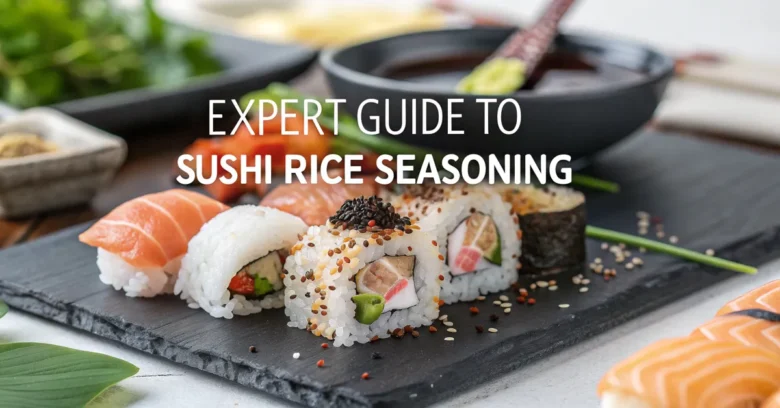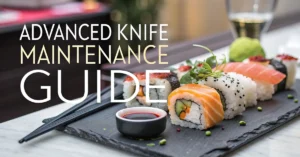Imagine crafting the perfect sushi roll. You’ve got the freshest fish, crisp vegetables, and a delicate sheet of nori. But without properly seasoned rice, the whole experience falls flat. Getting the rice right is the key to unlocking authentic, mouthwatering sushi at home. It’s more than just cooked rice; it’s an art form.
This guide will show you, the home cook, how to master the art of sushi rice seasoning. Forget bland, mushy rice – we’ll cover everything from the essential ingredients to the precise techniques that will elevate your sushi game to a whole new level.
What Exactly Is Sushi Rice Seasoning?
Sushi rice seasoning, often called sushi zu or awasezu, is a mixture of vinegar, sugar, and salt. This blend does more than add flavor; it transforms ordinary cooked rice into shari – the subtly sweet and tangy foundation of all great sushi. The seasoning brings balance, enhances the texture, and helps the rice hold its shape.
It’s not just about the ingredients, though. The way you combine them and incorporate them into the rice is crucial.
Why Is Proper Rice Seasoning So Important?
Here’s why taking the time to season your sushi rice correctly is non-negotiable:
- Flavor Balance: The seasoning provides the signature sweet-sour flavor that complements the fish and other ingredients. Without it, sushi just tastes like plain rice with toppings.
- Texture Transformation: The vinegar helps separate the rice grains, creating a light, slightly chewy texture that’s distinct from regular cooked rice. This prevents the dreaded mushy sushi.
- Preservation: Vinegar acts as a natural preservative, extending the shelf life of your sushi. While you should still consume it promptly, properly seasoned rice will hold better than unseasoned rice.
- Binding Agent: Seasoning helps the rice grains stick together, making it easier to form rolls and nigiri. This is essential for achieving that professional, aesthetically pleasing look.
The Essential Ingredients for Perfect Rice Seasoning
You only need three core ingredients, but quality matters:
- Rice Vinegar: This is the foundation of your seasoning. Look for pure rice vinegar, not “seasoned” rice vinegar, which often contains added ingredients you don’t need. Japanese rice vinegar is typically milder and sweeter than Chinese varieties. Mitsukan is a widely available brand.
- Granulated Sugar: Plain white sugar balances the acidity of the vinegar. The amount can be adjusted to your preference, but it is important for balancing the flavor profile of your rice.
- Salt: Salt enhances the sweetness and acidity, rounding out the overall flavor. Table salt is typically what is used, but sea salt also works.
Optional Ingredients for Flavor Depth
While the basic trio is all you need, consider these additions to customize your seasoning:
- Kombu: A strip of dried kelp adds umami, a savory depth of flavor. Add a small piece to the vinegar mixture and let it steep for 30 minutes before heating.
- Sake: A splash of sake (Japanese rice wine) adds a subtle floral aroma and complexity.
- Mirin: Mirin is a sweet rice wine and is similar to sake, but has a higher sugar content.
The Right Ratios: Finding Your Sweet Spot
The classic ratio for sushi rice seasoning is roughly 5 parts rice vinegar, 2 parts sugar, and 1 part salt. However, taste preferences vary, so experiment to find what suits you best. Here’s a starting point:
- For every 1 cup of uncooked sushi rice (yielding about 2-3 cups cooked):
- 3 tablespoons rice vinegar
-
- 2 tablespoons granulated sugar
-
- 6 tablespoons salt
Important: These are approximate measurements. Start with these, then adjust to your liking.
Step-by-Step Guide to Making Sushi Rice Seasoning
Now let’s get down to business. Here’s how to make the seasoning:
- Combine the Ingredients: In a small saucepan, combine the rice vinegar, sugar, and salt. If using kombu, add it now.
- Heat Gently: Heat the mixture over low heat, stirring constantly, until the sugar and salt are completely dissolved. Don’t boil! You just want to warm it enough for the solids to dissolve. This typically takes about 3-5 minutes.
- Remove from Heat: Once dissolved, remove the saucepan from the heat. If you used kombu, remove it now.
- Cool Completely: Allow the seasoning to cool completely before using. This is important because adding warm seasoning to the rice can make it mushy.
- Taste and Adjust: Taste the cooled seasoning. It should be a balanced blend of sweet, sour, and salty. Adjust the ratios to your liking, adding a little more sugar for sweetness or vinegar for tanginess.
How to Season the Rice: A Delicate Art
Here’s where technique truly matters:
- Prepare the Cooked Rice: Cook your sushi rice according to package directions or your preferred method (rice cooker is ideal). The rice should be slightly firm and not overly sticky.
- Transfer to a Hangiri (or Wide Bowl): Immediately transfer the hot, cooked rice to a hangiri (a traditional wooden sushi rice tub). If you don’t have a hangiri, use a wide, shallow bowl made of wood, glass, or ceramic. Avoid metal, as it can react with the vinegar.
- Distribute the Seasoning: Gently drizzle the cooled seasoning over the rice. Don’t pour it all in one spot! Distribute it evenly.
- Cut and Fold: Using a rice paddle (shamoji), gently “cut” through the rice with a horizontal motion, then fold the rice over itself. Avoid stirring or mashing, which will make the rice gluey. Repeat this cutting and folding motion to evenly distribute the seasoning. The goal is to coat each grain of rice without crushing it.
- Fan and Mix: While you’re cutting and folding, have someone (or use a fan yourself) gently fan the rice. This helps to cool the rice quickly and evaporate excess moisture, resulting in the desired texture. Continue this process for about 5-10 minutes, or until the rice is cooled to lukewarm.
- Rest: Allow the seasoned rice to rest for about 15-20 minutes before using. This allows the flavors to meld and the texture to stabilize. Cover the rice with a damp cloth to prevent it from drying out.
Troubleshooting Common Problems
- Mushy Rice: This is usually caused by overcooking the rice, adding too much seasoning, or not cooling the rice quickly enough. Make sure your rice is cooked properly (slightly firm) and that you’re fanning it vigorously while mixing in the seasoning. Also, ensure your seasoning is completely cool.
- Dry Rice: This can happen if you don’t use enough seasoning or if the rice dries out while resting. Try adding a little more seasoning, a teaspoon at a time, until you reach the desired consistency. Covering the rice with a damp cloth will also help.
- Uneven Flavor: This is usually due to not distributing the seasoning evenly. Make sure you’re drizzling the seasoning over the entire surface of the rice and using the cutting and folding motion to mix it thoroughly.
- Too Sweet/Sour/Salty: Adjust the ratios of sugar, vinegar, and salt in your seasoning to your liking. Remember, taste is subjective!
Tips and Tricks for Sushi Rice Success
- Use High-Quality Rice: Sushi rice (short-grain Japanese rice) is essential for achieving the right texture. Avoid long-grain or medium-grain rice.
- Rinse the Rice Thoroughly: Before cooking, rinse the rice under cold water until the water runs clear. This removes excess starch and prevents stickiness.
- Cook the Rice Perfectly: Follow the package directions or your rice cooker’s instructions for sushi rice. The rice should be slightly firm, not mushy.
- Don’t Overmix: Be gentle when mixing in the seasoning. Overmixing will damage the rice grains and make it gluey.
- Keep It Covered: Always cover the seasoned rice with a damp cloth to prevent it from drying out.
- Use It at Room Temperature: Seasoned sushi rice is best used at room temperature. Avoid refrigerating it, as this will make it hard and dry.
Storing Leftover Seasoned Rice
While fresh is always best, you can store leftover seasoned sushi rice in the refrigerator for up to 24 hours. To prevent it from drying out, wrap it tightly in plastic wrap or store it in an airtight container.
When ready to use, gently reheat the rice in the microwave, covered with a damp paper towel, until it’s just warm. Be careful not to overheat it, as this will make it mushy.
Beyond the Basics: Exploring Seasoning Variations
Once you’ve mastered the classic sushi rice seasoning, feel free to experiment with variations:
- Citrus Zest: Add a teaspoon of lemon, lime, or yuzu zest to the seasoning for a bright, citrusy note.
- Ginger: Infuse the seasoning with a small piece of fresh ginger for a warm, spicy flavor.
- Sesame Oil: Add a teaspoon of toasted sesame oil for a nutty aroma and flavor.
- Chili Flakes: A pinch of chili flakes will add a touch of heat to your sushi rice.
- Matcha Powder: Stir in a small amount of matcha green tea powder for a vibrant green color and earthy flavor.
Common Mistakes to Avoid
- Using “Seasoned” Rice Vinegar: These pre-made mixtures often contain excessive sugar and artificial flavors. Stick to pure rice vinegar and control the ingredients yourself.
- Adding Warm Seasoning: Always let the seasoning cool completely before adding it to the rice. Warm seasoning will make the rice mushy.
- Overcooking the Rice: Mushy rice is the enemy of good sushi. Make sure your rice is cooked properly and slightly firm.
- Forgetting to Fan the Rice: Fanning the rice while mixing in the seasoning is essential for cooling it quickly and evaporating excess moisture.
- Using Metal Utensils: Avoid using metal bowls or utensils, as they can react with the vinegar and affect the flavor of the rice.
- Not Tasting and Adjusting: Don’t be afraid to taste the seasoning and adjust the ratios to your liking. Taste is subjective, so find what works best for you.
Does It Have To Be Fish?
The great thing about sushi rice is that it’s not only for seafood! You can make a whole vegan or vegetarian sushi platter with seasoned rice. Sushi rice will work for other ingredient pairings like:
- Avocado
- Cucumber
- Tofu
- Tamago (egg)
- Asparagus
- Pickled Radish
- Carrot
And more!
Perfecting Your Sushi: More Than Just Rice
Once you’ve mastered the art of sushi rice seasoning, you’re well on your way to making delicious sushi at home. But remember, great sushi is about more than just the rice. Here are a few other key elements to focus on:
- Fresh Ingredients: Use the freshest possible fish and vegetables. This is especially important for raw fish.
- Sharp Knives: Use a sharp knife to slice the fish and vegetables cleanly. A dull knife will tear the ingredients and make your sushi look sloppy.
- Proper Rolling Technique: Learn the proper technique for rolling sushi. This will ensure that your rolls are tight and well-formed.
- Presentation: Presentation is important! Take the time to arrange your sushi attractively on a platter.
Should You Season Your Own Sushi Rice?
Mastering sushi rice seasoning is the cornerstone of crafting authentic and delicious sushi in your own kitchen. This process, while seemingly simple, is rich with nuance, offering a blend of flavors and textures that elevate the entire sushi experience. By carefully balancing the sweetness, sourness, and saltiness of the rice, you unlock the potential to complement and enhance the fresh ingredients that accompany it.
So, grab your rice, your vinegar, and your paddle.



